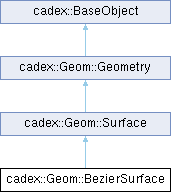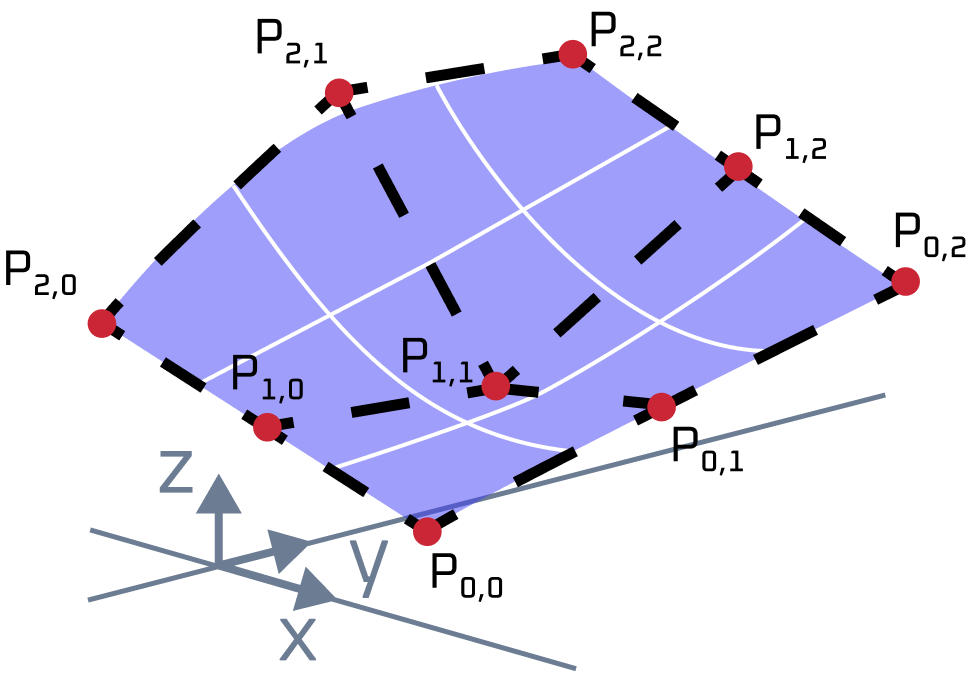Defines a Bezier surface. More...
#include <cadex/Geom/BezierSurface.hxx>

Public Member Functions | |
| BezierSurface () | |
| Constructor. | |
| BezierSurface (const std::vector< Point > &thePoles, int theNumberOfUPoles, int theNumberOfVPoles) | |
| Constructor. | |
| BezierSurface (const std::vector< Point > &thePoles, const std::vector< double > &thePoleWeights, int theNumberOfUPoles, int theNumberOfVPoles) | |
| Constructor. | |
| int | UDegree () const |
| Returns degree. | |
| int | VDegree () const |
| Returns degree. | |
| int | NumberOfUPoles () const |
| Returns number of U-poles. | |
| int | NumberOfVPoles () const |
| Returns number of V-poles. | |
| Point | Pole (int theUIndex, int theVIndex) const |
| Returns a pole value. | |
| std::vector< Point > | Poles () const |
| Populates a 2D table of poles. | |
| double | Weight (int theUIndex, int theVIndex) const |
| Returns a weight value. | |
| std::vector< double > | Weights () const |
| Populates a 2D table of weights. | |
 Public Member Functions inherited from cadex::Geom::Surface Public Member Functions inherited from cadex::Geom::Surface | |
| Surface () | |
| Constructor. | |
| SurfaceType | Type () const |
| Returns a surface type. | |
| Geom::Continuity | Continuity () const |
| Returns a continuity type of the surface. | |
| Point | Value (double theParameterU, double theParameterV) const |
| Evaluates a point on the surface. | |
| Direction | Normal (double theParameterU, double theParameterV) const |
| Returns the normal direction theNormal at the current point. | |
| bool | IsUPeriodic () const |
| Returns true if the surface is periodic in U direction. | |
| bool | IsVPeriodic () const |
| Returns true if the surface is periodic in V direction. | |
| double | UMin () const |
| Returns a minimum parameter of a definition domain in U direction. | |
| double | UMax () const |
| Returns a maximum parameter of a definition domain in U direction. | |
| double | VMin () const |
| Returns a minimum parameter of a definition domain in V direction. | |
| double | VMax () const |
| Returns a maximum parameter of a definition domain in V direction. | |
| void | Domain (double &theUMin, double &theUMax, double &theVMin, double &theVMax) const |
| Returns a definition domain. | |
| bool | IsTrimmed () const |
| Returns whether surface is trimmed or not. | |
| void | SetTrim (double theUFirst, double theULast, double theVFirst, double theVLast) |
| Trims surface with [theUFirst, theULast] x [theVFirst, theVLast] section. | |
| void | Transform (const Transformation &theTransformation) |
| Applies transformation matrix to this object. | |
| Surface | Transformed (const Transformation &theTransformation) const |
| Returns a copy this object after applying transformation. | |
| void | D0 (double theParameterU, double theParameterV, Point &theValue) const |
| Returns the point theValue of parameter theU, theV on the surface. | |
| void | D1 (double theParameterU, double theParameterV, Point &theValue, Vector &theD1U, Vector &theD1V) const |
| Returns the point theValue and the first derivatives in the directions U theD1U and V theD1V at this point. | |
| void | D2 (double theParameterU, double theParameterV, Point &theValue, Vector &theD1U, Vector &theD1V, Vector &theD2U, Vector &theD2V, Vector &theD2UV) const |
| Returns the point theValue, the first and the second derivatives in the directions U and V at this point. | |
| bool | DN (double theParameterU, double theParameterV, size_t theDerivativeOrder, Geom::Point &theValue, std::vector< Geom::Vector > &theD) const |
| void | Curvature (double theParameterU, double theParameterV, Direction &thePrincipalMaxDirection, Direction &thePrincipalMinDirection) const |
| Returns the max and min principal curvature directions multiplied by max and min value of curvature respectively. | |
| void | Curvature (double theParameterU, double theParameterV, Direction &thePrincipalMaxDirection, Direction &thePrincipalMinDirection, double &theMaxCurvature, double &theMinCurvature) const |
| Returns the max and min principal curvature directions and their values. | |
| void | Mirror (const Point &thePoint) |
| void | Mirror (const Axis1d &theAxis) |
| void | Mirror (const Axis3d &theAxis) |
| Surface | Mirrored (const Point &theRef) const |
| Surface | Mirrored (const Axis1d &theAxis) const |
| Surface | Mirrored (const Axis3d &theAxis) const |
| void | Rotate (const Axis1d &theAxis, double theAngle) |
| Surface | Rotated (const Axis1d &theAxis, double theAngle) const |
| void | Translate (const Vector &theVector) |
| Surface | Translated (const Vector &theVector) const |
| void | Scale (const Point &thePoint, double theScale) |
| Surface | Scaled (const Point &thePoint, double theScale) const |
 Public Member Functions inherited from cadex::BaseObject Public Member Functions inherited from cadex::BaseObject | |
| size_t | Id () const |
| Return unique identifier of public object. | |
| internal::BaseObjectImpl * | Impl () const |
| bool | IsNull () const |
| operator bool () const | |
| template<typename T > | |
| bool | IsOfType () const |
| template<typename T > | |
| T * | Impl () const |
| Reserved for internal use. | |
Static Public Member Functions | |
| static bool | CompareType (const BaseObject &theObject) |
 Static Public Member Functions inherited from cadex::Geom::Surface Static Public Member Functions inherited from cadex::Geom::Surface | |
| static bool | CompareType (const BaseObject &theObject) |
 Static Public Member Functions inherited from cadex::Geom::Geometry Static Public Member Functions inherited from cadex::Geom::Geometry | |
| static bool | CompareType (const BaseObject &theObject) |
Additional Inherited Members | |
 Public Types inherited from cadex::BaseObject Public Types inherited from cadex::BaseObject | |
| typedef std::shared_ptr< internal::BaseObjectImpl > | ImplType |
 Protected Member Functions inherited from cadex::Geom::Surface Protected Member Functions inherited from cadex::Geom::Surface | |
| Surface (const ImplType &theImpl) | |
 Protected Member Functions inherited from cadex::Geom::Geometry Protected Member Functions inherited from cadex::Geom::Geometry | |
| Geometry (const ImplType &theImpl) | |
 Protected Member Functions inherited from cadex::BaseObject Protected Member Functions inherited from cadex::BaseObject | |
| BaseObject (const ImplType &theImpl) | |
Defines a Bezier surface.
Bezier surface is defined by control points (poles) and their weights. The following image depicts an example of a Bezier surface:

For introduction to and mathematical definition of Bezier surface please refer to external resources, for instance:
A rational Bezier surface contains an explicit vector of weights, whereas polynomial does not.
The surface degree equals number of poles minus one. Degree up to 25 is supported.
The Bezier surface is always considered non-periodic.
| cadex::Geom::BezierSurface::BezierSurface | ( | const std::vector< Point > & | thePoles, |
| int | theNumberOfUPoles, | ||
| int | theNumberOfVPoles ) |
Constructor.
Creates a polynomial Bezier surface.
thePoles contains a 2D table of poles, with size equal to theNumberOfUPoles * theNumberOfVPoles. theNumberOfUPoles and theNumberOfVPoles must be >=2 each.
| cadex::Geom::BezierSurface::BezierSurface | ( | const std::vector< Point > & | thePoles, |
| const std::vector< double > & | theWeights, | ||
| int | theNumOfUPoles, | ||
| int | theNumOfVPoles ) |
Constructor.
Creates a rational Bezier surface.
thePoles contains a 2D table of poles, with size equal to theNumberOfUPoles * theNumberOfVPoles. theNumberOfUPoles and theNumberOfVPoles must be >=2 each.
thePoleWeights defines pole weights and must have the same size and layout as thePoles;
| int cadex::Geom::BezierSurface::NumberOfUPoles | ( | ) | const |
Returns number of U-poles.
Returns the value specified in the constructor.
| int cadex::Geom::BezierSurface::NumberOfVPoles | ( | ) | const |
Returns number of V-poles.
Returns the value specified in the constructor.
| Point cadex::Geom::BezierSurface::Pole | ( | int | theUIndex, |
| int | theVIndex ) const |
Returns a pole value.
theUIndex must be in the range [1, NumberOfUPoles()], theVIndex in the range [1, NumberOfVPoles()].
| std::vector< Point > cadex::Geom::BezierSurface::Poles | ( | ) | const |
Populates a 2D table of poles.
thePoles must point to a buffer in memory with at least NumberOfUPoles() * NumberOfVPoles() preallocated values.
Returns NumberOfUPoles() * NumberOfVPoles().
| int cadex::Geom::BezierSurface::UDegree | ( | ) | const |
Returns degree.
Returns the value equal to NumberOfUPoles() - 1.
| int cadex::Geom::BezierSurface::VDegree | ( | ) | const |
Returns degree.
Returns the value equal to NumberOfVPoles() - 1.
| double cadex::Geom::BezierSurface::Weight | ( | int | theUIndex, |
| int | theVIndex ) const |
Returns a weight value.
theUIndex must be in the range [1, NumberOfUPoles()], theVIndex in the range [1, NumberOfVPoles()].
For polynomial Bezier surface behavior is undefined.
| std::vector< double > cadex::Geom::BezierSurface::Weights | ( | ) | const |
Populates a 2D table of weights.
thePoles must point to a buffer in memory with at least NumberOfUPoles() * NumberOfVPoles() preallocated values.
Returns NumberOfUPoles() * NumberOfVPoles().